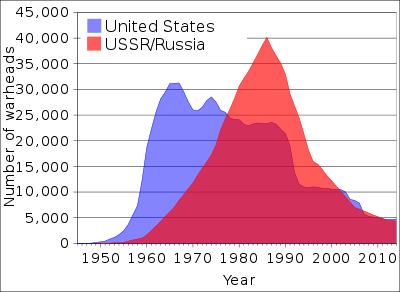After the United States succeeded at making the nuclear bombs in the Manhattan Project and used them to end the war with Japan in World War II, it became clear to the world that from this day forward nuclear weapons were going to shift the balance of powers in the modern world. After World War II ended and the Cold War immediately started between the United States and the Soviet Union, the two countries entered an unannounced arms race where each country tried to acquire and build more nuclear missiles than the other.
Nuclear power means a superpower
Being able to demolish an entire city along with the lives of tens of thousands of people with a single bomb is both very powerful and dangerous. During this time period, if a country obtained nuclear weapons, they would be considered very powerful and to be feared. At the same time, if the enemy were to obtain the same nuclear weapon, that poses an everlasting threat.
Such a threat came to reality in 1949 when the Soviet Union managed to produce its first nuclear bomb. This came as a shock to the free world as no one ever anticipated how close the Soviet Union was to having a nuclear bomb. The United States could not allow the communist Soviet Union to have equal power in arms and as a result, the Arms Race between the United States and the Soviet Union began.

The Arms Race heats up
In 1952, the United States made and successfully tested its first hydrogen bomb, which was more powerful than the Soviet’s atomic bomb created in 1949. Shortly after, in 1953, the Soviet’s detonated their own hydrogen bomb.
Throughout the 1950s, the United States and the Soviet Union both started developing a special kind of missile that was able to hit targets from long range, up to 3,000 miles away. These missiles were called Intercontinental Ballistic Missiles (ICBMs) in reference to the missiles’ ability to cross continents.
This dangerous race for destruction left people fearful that a physical war would start. Therefore, both countries started working on their defenses as well. Huge radar arrays were built to detect if any missile were launched. The military also started working on counter-missiles to be able to destroy the ICBM missiles, if ever launched.
Seeing that the world was on the brink of a nuclear war that could end the human civilization and, possibly, the world, people started to build underground shelters where they could safely reside in case a war broke out. Governments also built huge underground facilities to ensure the safety of the government members.
Balance of powers
Luckily for both sides of the Arms Race, the Cold War never resulted in a nuclear war. Because both the democrat and the communist sides of the Cold War knew that the other country was armed enough to counterattack, which would result in the destruction of the entire country that launched the first missile, both the United States and the Soviet Union refrained from starting a nuclear war with each other.
Another factor that helped with balancing the powers were other countries that were also developing nuclear weapons. Those countries were France and Great Britain from the capitalist side and China from the communist side.

The Arms Race ends
As the years went by, it became extremely expensive for both countries to create more weapons to keep up with the Arms Race. As the two countries began to talk, they started to ease their tensions with each other, called détente.
At one point, towards the end of the Arms Race, the Soviet Union was spending over 27% of the country’s income on this aspect alone; this contributed massively to the economic problems in the Soviet Union in the 1980s, which led to its collapse in 1991. After the Soviet Union was dissolved, the Arms Race came to a natural end as there were no more threats of a communist nuclear attack on the western world.
Back to Cold War topics
